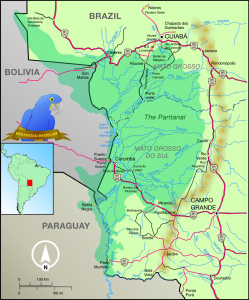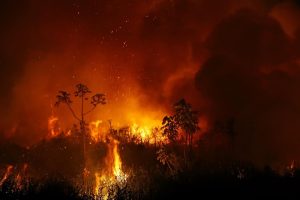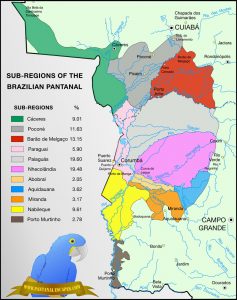Burning Brazil
Written by Erin Yoo
Edited by JuWon Park and Eunice Kim
The Pantanal is burning. As the largest natural wetland in the world, the Pantanal is home to thousands of plant and animal species, many of which are endangered (Burchard-Levine, 2020). It’s located in the southwest corner of Brazil by Bolivia and covers approximately 140,000 square kilometers, or 54,000 square miles, though its boundaries fluctuate due to changing rivers and floodwater (“Pantanal Maps”, 2019).

Image Credits to Pantanal Escapes.
Also note that the Pantanal is not actually one homogeneous area. It is a mixture of many different ecosystems including forests, grassland, marshes, and scrubs (“Pantanal Environment” 2019; “Pantanal Maps” 2019).
From January to August of 2020, there have been over 8,000 fires in the Pantanal, more than two times the amount of fires from January to August of 2019, according to data from the National Institute for Space Research (INPE or ‘Instituto Nacional de Pesquisas Espaciais’) (Burchard-Levine, 2020). It has lost over 1.2 million hectares—100 square meters—of land and multiple rare and endangered species (Burchard-Levine, 2020).
The Pantanal is extremely important due to its biodiversity: it’s a crucial habitat for one thousand animal species, notably jaguars, and much plant life. What’s more alarming is that thirty-six of those animal species are already in danger of becoming extinct (Burchard-Levine, 2020). Additionally, the Pantanal is also home to one million Indigenous people. For these reasons, it has been deemed a World Heritage site by UNESCO, an organization that serves to protect and conserve important natural and cultural sites (Burchard-Levine, 2020; “World Heritage”, 2020). Yet, fires have continued to scorch this valuable ecosystem.

Image Credits to Reuters.
Photo of the burning Pantanal.
The problem is incredibly complex because there are many factors that play a role in creating and sustaining these devastating fires. For one, increasing and intensifying agriculture as well as cattle ranching is a large part of the problem. Farmers and ranchers usually burn small plots of land in order to make room for crops and pastures, and the moment these fires get out of control, wildfires bloom (Burchard-Levine, 2020). Furthermore, lack of government regulation, fueled by economic want, further worsens the situations in which these fires erupt and spread (Burchard-Levine, 2020). This is largely due to the economic importance of cattle ranchers, whose work makes up 80% of the economy and are also central to the culture and history of the Pantanal (“People and Culture”, 2019). In fact, the Pantanal has been used as cattle ranching grounds for over three centuries (“History” 2019). Relatedly, 95% of the Pantanal is privately owned by landowners, “smallholder” farmers, and “large-scale” cattle ranchers (Burchard-Levine, 2020). Under the current president Jair Bolsonaro, the Brazilian government has reduced funding and opposed environmental preservation and protection, affecting more than just the Pantanal (Burchard-Levine, 2020). Thus, even though ranchers are nominally restricted in the fires they can start to clear land, illegal fires are not punished by the government (Burchard-Levine, 2020).
Adverse environmental conditions are also an important contributor to the raging fires. Due to a poor rainy season, the Paraguay River currently has the lowest levels of water it has ever seen in fifty years, lowering humidity levels and resulting in dry weather that is perfect for wildfires to flourish (Burchard-Levine, 2020). Additionally, high temperatures, strong wind, and a drought that removes moisture from the area make up even more unfavorable conditions (Burchard-Levine, 2020). Because of the fact that these are not short-term conditions, the fires will probably come back next year (Burchard-Levine, 2020).
Location-wise, the Pantanal is situated in a way that makes it subject to extreme temperatures, furthering the development of destructive fires. In the summer, temperatures can reach 45 degrees Celsius, or about 113 degrees Fahrenheit. These high temperatures are even more harmful when coupled with infrequent rainfall and low water levels, transforming the Pantanal into a desert (“Pantanal Environment”, 2019). Business plans, such as the ‘Hidrovia’ Plan, make this even more likely of a reality. This plan involves deepening the Paraguay River to reduce transportation costs for crops and other exports (“Pantanal Environment”, 2019). However, the Paraguay River is the only draining point for the Pantanal so deepening the river will dry out the region and decrease the amount of water in lakes and groundwater (“Pantanal Environment”, 2019). This is also dangerous for the people as more water within the Paraguay River could lead to flooding that could destroy homes and communities (“Pantanal Environment”, 2019).
The effects of the fires are fairly straightforward, though the nature of the problem makes them complex and challenging to solve. The fires result in damage to wildlife, release of particles in the air (which can be harmful for locals), and infertile soil, ultimately hurting the farmers themselves (Burchard-Levine, 2020). As stated previously, wetlands also provide a variety of ecosystem services including lessening the impact of heavy rainfall, slowing down flooding and thus reducing erosion, filtering out contaminants in water, and providing nurseries for fish spawning which supports the economy (“Pantanal Environment”, 2019). All in all, effective solutions will have to be complex as well as timely in order to successfully address this problem (Burchard-Levine, 2020).

Image Credits to Pantanal Escapes.
The sub-regions of the diverse Pantanal are depicted here.
References
Burchard-Levine, Antonia. (2020, September 28). The world’s largest wetland is on fire. EcosiaBlog, https://blog.ecosia.org/what-is-the-pantanal-and-why-is-it-burning/
History of the Pantanal. (2019). Pantanal Escapes, https://www.pantanalescapes.com/history/
The Pantanal Environment. (2019). Pantanal Escapes, https://www.pantanalescapes.com/about/environment.html
Pantanal Maps. (2019). Pantanal Escapes, https://www.pantanalescapes.com/locations/map.html
People and Culture. (2019). Pantanal Escapes, https://www.pantanalescapes.com/culture/
World Heritage. (2020). UNESCO World Heritage Centre, https://whc.unesco.org/en/about/
Image Credit: https://widerimage.reuters.com/story/in-brazil-its-not-just-the-amazon-thats-burning-the-worlds-largest-wetland-is-on-fire-too?